
* By the late 1950s, piston-powered executive aircraft were commonplace. With encouragement through military funding, aircraft manufacturers designed jet-powered business aircraft to bring the technology into the modern age. The pioneering "business jet" aircraft included the Lockheed "Jetstar" and the North American / Rockwell "Sabreliner", which were built in moderate quantities but had long service lives. This document provides a history and description of the Jetstar and Sabreliner -- as well as the "McDonnell 119/220", a competitor to the Jetstar that didn't go into production. A list of illustration credits is included at the end.

* In 1956, the US Air Force (USAF) issued a "general design specification (GDS)" for two light jet transports, including a twin-engine machine with four passenger seats, for the training / utility role, designated the "Utility-Trainer Experimental (UTX)"; and a larger, four-engine light airliner / utility transport, the "Utility-Cargo Experimental (UCX)". The GDS was not really a request for proposals, in anticipation of a contract award; the Air Force it had no money to issue a development contract, and any companies working on the UTX or UCX would have to do it on company funds. The most that could be said, if not really promised, by the USAF was that the service would be interested in buying a quantity of aircraft in both categories if companies developed them on their own funds -- suggesting a buy of 1,500 UTX and 300 UCX aircraft.
The quantities were tempting, the lack of commitment discouraging. However, US aviation companies had been interested in developing a light jetliner for the civil market anyway, and the UTX-UCX requirement was more or less just a prod in the right direction. The Lockheed company decided to move ahead on a design for the UCX specification. The program was under the general direction of Clarence "Kelly" Johnson, Lockheed's chief designer.
The first of two prototypes of the "L-329 Jetstar" performed its initial flight on 4 September 1957, with test pilot Ray Goudey at the controls. The Jetstar was a sleek aircraft, of all-metal construction, with low-mounted swept wings, tricycle landing gear, and turbojet engines mounted on each side of the rear fuselage. It was a configuration that would become all but universal for executive jets.
The two prototypes were initially fitted with twin Bristol Siddeley Orpheus turbojets, one prototype being fitted with "slipper" fuel tanks on the front of the wings. The expectation was that the Orpheus would be built under license in the US, but talks fell through. In consequence, the second prototype was fitted with four Pratt & Whitney JT12 turbojets, mounted in side-by-side pairs, a pair on each side of the rear fuselage tail, with the updated aircraft performing its initial flight in mid-1960.
The scheme proving satisfactory, the four-engine configuration was adopted for production. The second prototype was also fitted with refined slipper tanks, while the original slipper tanks were switched to the first prototype, which would retain the twin Orpheus engines. Initial customer deliveries of the Lockheed "Jetstar I" were in 1961.
* The Jetstar I was built mostly of aircraft aluminum. The wings had 2-degree dihedral and 30-degree sweep at quarter-chord, with leading-edge flaps, split by the slipper tanks; double slotted flaps, also split by the slipper tanks; and ailerons, with manual control but hydraulic boost. Both leading-edge and trailing-edge flaps were hydraulically actuated. There was a hydraulically-actuated speed brake under the rear fuselage. The fuselage was slightly stretched relative to the prototypes.
The tail flight surfaces were also swept, with the tailplane mounted up on the tailfin, slightly above the line of the top of the fuselage -- the high mounting position kept them out of the engine exhaust. The elevators and the rudder were manually actuated, the elevators featuring hydraulic boost, the rudder featuring servo boost. There were trim tabs on the ailerons and rudder, while unusually the tailfin pivoted to provide tailplane trim; there was a distinctive unpainted strip at the base of the tailfin. There were pneumatic de-icing boots on the leading edges of both the wing and tail surfaces.
All gear assemblies had dual wheels, the main gear retracting inward from the wings to the fuselage, the nose gear retracting forward; photos of the initial prototype showed it to have single-wheel nose gear at the outset. The landing gear was hydraulically actuated, and featured antiskid brakes.
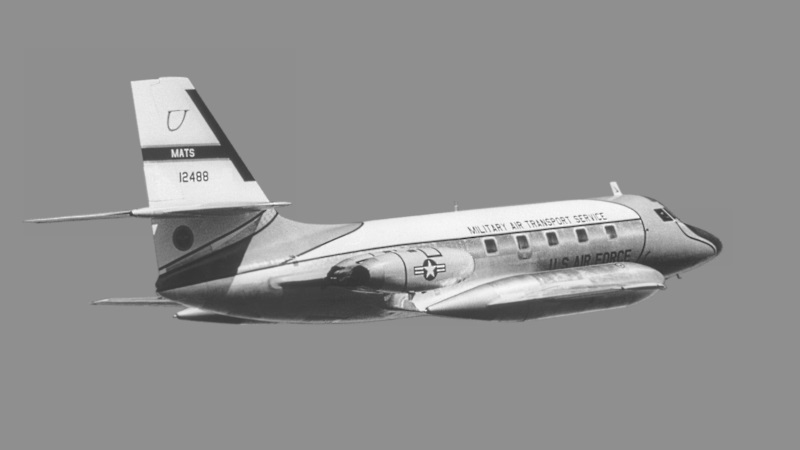
The Jetstar I was originally powered by JT12-6 turbojets with a maximum continuous thrust rating of 10.7 kN (1,090 kgp / 2,400 lbf) thrust. In 1963, the engines were updated to the JT12-6A variant with 11.5 kN (1,166 kgp / 2,570 lbf) thrust. A gas turbine auxiliary power unit (APU) for engine starting and ground power was available as an option. There were two internal fuel tanks in each wing, along with the slipper tank, for a total fuel supply of 10,070 liters (2,660 US gallons). Fuel management was a tricky issue for Jetstar aircrew.
___________________________________________________________________
LOCKHEED JETSTAR I:
___________________________________________________________________
wingspan:
16.6 meters (54 feet 5 inches)
wing area:
50.4 sq_meters (542.5 sq_feet)
length:
18.42 meters (60 feet 5 inches)
height:
6.23 meters (20 feet 5 inches)
empty weight:
10,012 kilograms (22,074 pounds)
MTO weight:
19,050 kilograms (42,000 pounds)
max speed at altitude:
910 KPH (565 MPH / 490 KT)
service ceiling:
11,400 meters (37,400 feet)
range, max load:
3,410 kilometers (2,120 MI / 1,845 NMI)
___________________________________________________________________
The Jetstar I carried two pilots and normally featured eight passenger seats, or ten in a high-density configuration, with a wardrobe, galley, and toilet in the rear. There were baggage compartments fore and aft. There were five windows on each side of the fuselage; there was a passenger door on the forward left side of the fuselage, with the door opening inward and stairs folding out. There was an emergency exit over each wing. The aircraft was pressurized and climate-conditioned.
Incidentally, the complications of using four engines, six fuel tanks, and indifferent cockpit design -- this was, after all, a time when the word "ergonomics" was not popularly understood -- led to the joke that a Jetstar needed no cockpit door lock, since nobody who hadn't been well-trained on the thing could figure out how to get it started, much less fly it. Getting into the cockpit also required contortions, particularly for taller pilots, though the field of view was said to be excellent.
The Jetstar I was not the most popular of the first-generation business jets -- one reason being that it was the biggest of them, and so had a more limited market. Total production of the Jetstar I was 164 machines, the last being built in 1973. Although the two prototypes had been built at the Lockheed facility in Burbank, California, all production machines would be built at the Lockheed plant in Marietta, Georgia.
The 300 aircraft envisioned by the Air Force for the UCX effort didn't pan out, but the USAF did obtain sixteen Jetstar Is, in two variants:
The US Navy also ordered two "C-140C" Jetstars, but the order was canceled; the Air Force also considered a trainer version of the Jetstar, the "T-40", but it didn't happen. The Jetstar was obtained by a number of foreign military services, including Germany, Indonesia, Iran, Iraq, Kuwait, Libya, Mexico, and Saudi Arabia, for use in liaison, utility, and VIP transport roles. The Jetstar was said to have carried an unusual number of heads of state. One was used by the US National Aeronautics & Space Administration as a testbed aircraft, in one instance with an experimental turboprop engine on a pylon mounted on the back.

* From 1967, Jetstar Is were built to "Dash 8" standard, with JT12A-8 turbojets providing 14.7 kN (1,495 kgp / 3,300 lbf); the earlier engine variants left the aircraft underpowered. The Dash 8 was also stressed for higher take-off weight, and had improved brakes, plus a pneumatic emergency extension system for the landing gear.
By the beginning of the 1970s, the Jetstar I's turbojet engines were well behind the times, being too noisy, too dirty, and too thirsty. The result was the "L-1329 Jetstar II", which swapped out the JT12 turbojets with much quieter, cleaner, and more fuel-efficient Garrett (later Honeywell) TFE 731 turbofan engines -- providing 16.5 kN (1,680 kgp / 3,700 lbf) thrust each -- along with new slipper tanks; the old slipper tanks were midbody-mounted, the new larger ones were slung under the wings. The only other significant change was the addition of single-point refueling, with individual tank refueling retained.

The Jetstar II was quieter and cleaner than the Jetstar I. Range was improved to 4,630 kilometers (2,875 MI / 2,500 NMI). 40 were built, bringing total Jetstar production to 204 machines. A number of Jetstar Is were also updated to "Jetstar 731" standard, with the TFE731 engines and underslung slipper tanks.
The American Aviation Industries (AAI) Company decided to set up a program to modernize old Jetstar airframes for commercial sale, and accordingly developed a "Fanstar" prototype, rebuilt from a Jetstar I. The primary change was switch of the four JT12 turbojets for twin General Electric CF34 turbofans -- a civil version of the TF34 turbofan used on the Lockheed S-3 Viking carrier-based antisubmarine warfare aircraft and Fairchild A-10 Warthog close-support aircraft, the CF34 being popular on regional jetliners.
The Fanstar prototype flew in 1986, but the exercise collapsed, with AAI ending up in court. However, such Jetstars IIs as remain flying have in many cases been updated with improved TFE731 engine variants, as well as modernized cockpit avionics. It seems refurbished Jetstars proved popular with Eastern European governments after the fall of the Soviet Union, since it was a roomy and capable aircraft at a bargain price.
BACK_TO_TOP* When the USAF came up with the UCX-UTX specification in 1956, the North American Aviation company decided to pursue the smaller UTX trainer, having been working on concepts for a small twinjet transport aircraft from 1952. Even if the UTX business didn't amount to much, North American still felt their small twinjet had potential in the civil market.
The initial prototype -- the "NA-265" -- performed it maiden flight on 16 September 1958, with test pilots J.O. Roberts and Gage Mace at the controls. It was called the "Sabreliner", because it leveraged off the design of the flight surfaces for the North American F-86 Sabre fighter. Since no other companies chose to compete for the UTX, NAA won the contest by default. Although the prototype was powered by General Electric YJ85 turbojets, the production "T-39A" transport-trainer for the USAF featured P&W JT12A-8 turbojets. It went into service in 1962.
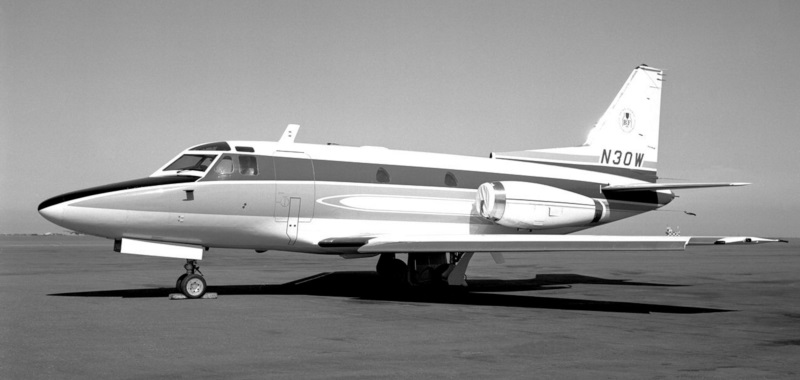
The military variants of the Sabreliner are discussed below; it is simpler to describe the evolution of the Sabreliner through the commercial variants. The first was the "Sabreliner Series 40", the civil equivalent of the T-39A, which had a roomier cabin and slightly better performance than the NA-265 prototype.
The Saberliner Series 40 was of all-metal construction, mostly of aircraft aluminum alloy. It had all-swept flight surfaces, with conventional control surfaces -- flaps, ailerons, rudder, elevators -- plus leading-edge slats. Pneumatic de-icing boots were optional. There was a large, hydraulically-operated airbrake under the forward fuselage, and an emergency exit on the belly behind the airbrake. The nose gear had twin wheels and retracted forward; the main gear had single wheels and retracted inward towards the fuselage.
The cockpit windows had topside "eyebrows" that provided a distinctive recognition feature for the type. Access to the aircraft was through a fold-down "airstair" door on the right front left of the fuselage. They were fitted out by the Renmert-Werner Company; executive / VIP configurations had four seats, but it appears six or a maximum of eight could be fitted. Early on, Renmert-Werner would sell the Sabreliner for North American, though eventually North American would sell it directly. The seats could be removed for hauling cargo. There was baggage storage forward, across from the door, and a lavatory in the rear.
___________________________________________________________________
NORTH AMERICAN ROCKWELL SABRELINER SERIES 40:
___________________________________________________________________
wingspan:
13.54 meters (44 feet 5 inches)
wing area:
31.78 sq_meters (342.1 sq_feet)
length:
13.34 meters (43 feet 9 inches)
height:
4.88 meters (16 feet)
empty weight:
4,488 kilograms (9,895 pounds)
MTO weight:
8,320 kilograms (18,340 pounds)
max cruise speed:
905 KPH (565 MPH / 490 KT)
service ceiling:
13,700 meters (45,000 feet)
range, max fuel:
3,380 kilometers (2,100 MI / 1,825 NMI)
___________________________________________________________________
Early production featured two passenger windows on each side -- in a rounded triangle configuration -- and was powered by two P&W JT12A-6A turbojets with 13 kN (1,360 kgp / 3,000 lbf) thrust each. From 1966, Sabreliner 40s featured three triangular windows on each side, and JT12A-8 turbojets with 10% more thrust. Thrust reversers were also offered as an option from that time, with other Sabreliner variants being offered with the same option.
A cost-reduced version of the Series 40, the seven-seat "Sabreliner Commander", was introduced in 1971; in 1972, with the introduction of a subvariant with higher take-off weight, both the standard Series 40 and the Sabreliner Commander were redesignated "Sabreliner Series 40A", with the latter being enhanced for higher take-off weight.
* The "Sabreliner Series 50" was strictly a one-off, flown in 1964, being a Series 40 with enhancements, most notably an uprated electrical system, for use as a company avionics trials aircraft.
The Series 40 was followed in production in 1967 by the "Sabreliner Series 60", which was stretched by 96 centimeters (38 inches), increasing the length from 13.34 to 14.3 meters (43 feet 9 inches to 46 feet 11 inches). Flight surfaces remained the same, and it also retained the JT12A-8 turbojets. In executive / VIP configuration, it featured six seats, but it could be fitted with eight or ten -- the stretch, it seems, was figured for another row of seats. There were five triangular windows on each side, plus an emergency exit over each wing. 130 were built. That same year, North American merged with Rockwell-Standard to become North American Rockwell.

The Sabreliner 60 was followed in turn by the "Sabreliner Series 70", marketed as the "Sabre 75", Rockwell having decided to trim the family name down for sales purposes -- though the series was in practice always called "Sabreliner" anyway. The Sabreliner 70/75 was similar to the Series 60, but had a taller cabin for more headspace and square windows instead of triangular windows. Only nine were built, since it still had JT12A-8 turbojet engines at a time when business jets were increasingly adopting turbofans.
In 1973, North American merged with Rockwell Standard, to become "Rockwell International". The "Sabreliner Series 80", sold as the "Series 75A", was a Series 70/75 with GE CF700D-2 turbofans, providing lower noise and emissions, plus greater range. The Series 80/75A also added air conditioning, better brakes, and more fuel capacity. 72 were built, with deliveries from early 1974. 15 of the total were obtained by the US Federal Aviation Administration for calibration of landing and navigation aid systems.
The Series 40 went out of production in 1974, after construction of 137 machines. In that timeframe, Rockwell considered a trijet "Sabre X" with extended range, but it came to nothing. Rockwell also proposed an "HT-39H" for a US Coast Guard maritime patrol requirement, but the Coast Guard chose the Dassault Falcon 20 instead, designating it the "HU-25".
* In 1976, Rockwell awarded a contract to Raisbeck Engineering of Seattle to redesign the Sabreliner's wing to a "supercritical" configuration -- featuring greater area, the removal of leading-edge slats, plus addition of a small fence on each wing and Fowler flaps. Rockwell used the new wing design to produce the "Series 65", powered by Garrett AiResearch TFE731-3R-1D turbofans.
Sabreliner 75As could also be refitted with the new wing, acquiring the designation of "Sabre 80A". Some sources mention Sabreliner 60 and 40 machines being updated to turbofans as well, but it is difficult to find any confirmation of that notion.
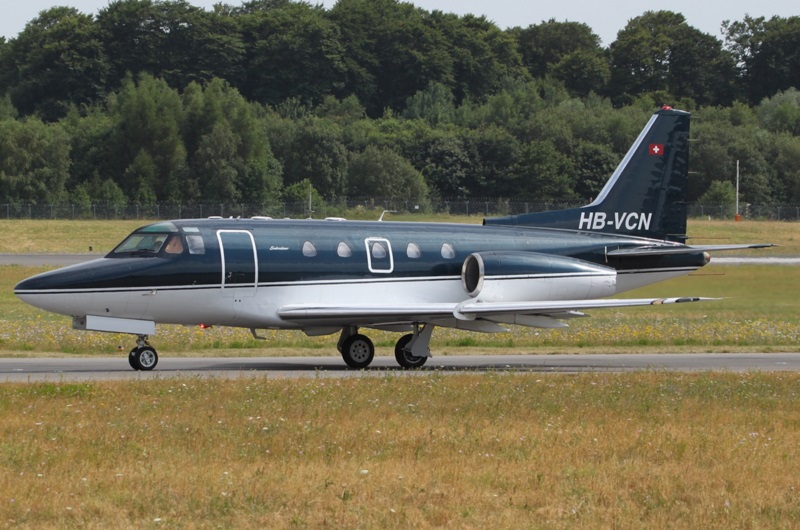
The Sabreliner 65 performed its initial flight on 8 April 1979, with deliveries from 1981. 76 Sabreliner 65s were built, the last being rolled out in 1982. It was the last variant of the Sabreliner series. In 1982, Rockwell sold off the Sabreliner assets to a private group, the result being "Sabreliner Corporation" -- which eventually evolved into the present-day "Sabreliner Services". The new company had plans to build the Sabreliner, focusing on a modernized, stretched, extended-range "Sabreliner 85", with extensive changes such as winglets and elimination of the distinctive eyebrow windows. It didn't happen.
However, the Sabreliner Corporation did provide service for Sabreliners in service, as well as updates of old Sabreliners. In 1989, the company began the "Excalibur" program to refurbish old Series 40 and Series 60 machines, the renewed machines being designated "Series 40EX" and "Series 60EX" respectively. They retained the JT12A-8 engines. Sabreliner Corporation has also provided avionics updates, as well as TFE 731 engine updates.
BACK_TO_TOP* The USAF T-39A was intended for the multi-engine pilot training role, being able to also operate as a four-seat utility / VIP transport. It was powered by P&W J60-P3 engines -- the J60 being the military equivalent of the JT12, the J60-P3 apparently being equivalent to the JT12-6, with 13 kN (1,360 kgp / 3,000 lbf) thrust. 143 T-39As were built, making it the most common military variant. All survivors were updated from 1967 for higher maximum take-off weight, being fitted for seven passengers.
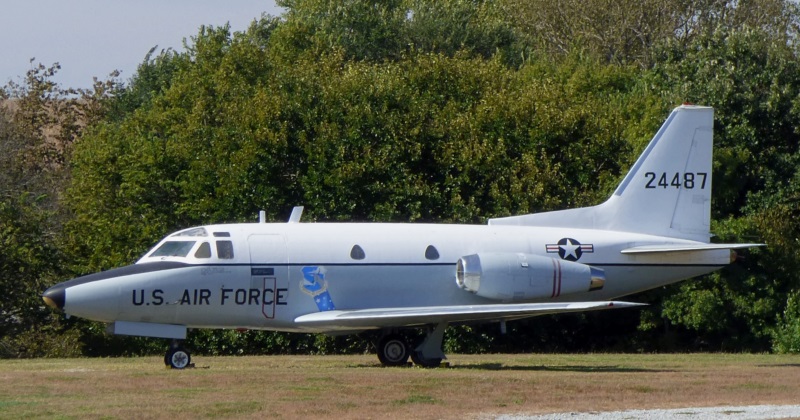
Some T-39As were configured as cargo / personnel transports, being designated "CT-39A", while one T-39A modified as an avionics trials platform was designated "NT-39A". Six T-39s were obtained by the USAF in parallel with the T-39A as "T-39B" trainers for the Republic F-105D fighter-bomber, these Sabreliners being fitted with the F-105's R-14 NASARR main radar, accommodated in a larger nose, and AN/APN-131 doppler radar, plus workstations for three trainees.
The Air Force also contemplated a similar "T-39C" to provide systems training for the McDonnell F-101B Voodoo interceptor. It didn't happen -- but some Air Force Sabreliners were converted to "T-39F" configuration, being fitted with electronic warfare kit for the Republic F-105G Wild Weasel defense-suppression aircraft. They were known as "Teeny Weeny Weasels". All Air Force T-39s, incidentally, were delivered with two passenger windows on each side of the fuselage. It is possible to find photos of "T-39s" with five windows on each side from airshows, but these appear to be stretched, turbofan-powered civilian Sabreliners simply redone in military colors.
In 1987, Sabreliner Corporation got a contract from the USAF for support of the Air Force T-39 fleet. The exercise involved a service-life extension of eight T-39As and two T-39Bs.
* The Navy obtained the Sabreliner as well, the initial variant being briefly designated "T3J-1", though none were delivered with that designation; the Navy actually obtained them with the designation of "T-39D", as a consequence of the Pentagon's unification of aircraft designations in 1962. The T-39D was originally envisioned as a radar trainer for the McDonnell F3H-1 Demon carrier-based jet fighter, though the Demon was out of service by the time the T-39D came up to speed.
The Navy obtained 42 T-39Ds, in three configurations:
As delivered, they all had two triangular windows on each side, just like all the USAF T-39s. In 1967, the Navy ordered seven Series 40 Sabreliners -- by that time, with the three windows -- for the global fleet support role, being fitted with long-range military navigation systems. These machines initially being designated "VT-39E", but quickly redesignated "CT-39E".
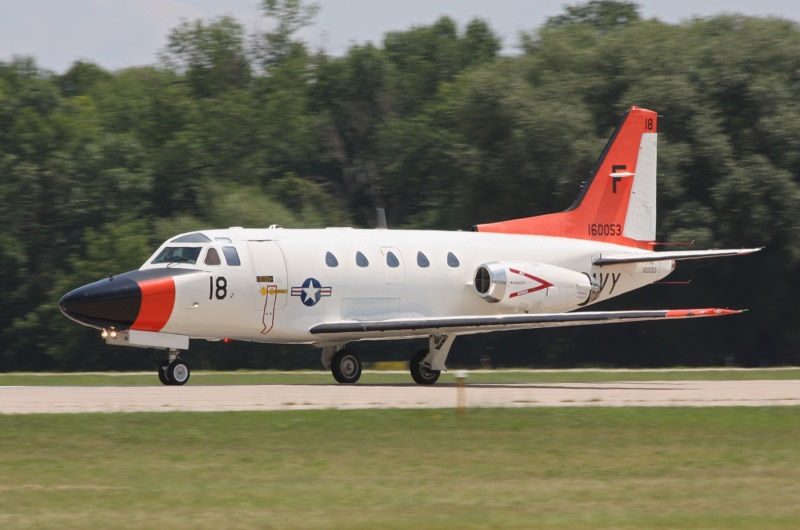
Navy also obtained 13 larger "CT-39G" cargo-transport machines, based on the Sabreliner Series 60, with some of them modified to "T-39G" standard for mission training; they only had weather radar. These were the only stretched Sabreliners obtained by the US military. In the early 1990s, Sabreliner Corporation also modified 15 Series 40 machines, obtained from the civil market, to "T-39N" standard for use with the UNFO program; they had AN/APG-66 multimode radar, allowing them to be used for air-to-air radar training, and radar navigation.
In sum, civil Sabreliner production included:
That gave total civil production as 426 machines. Military production included:
That gave military production as 211 machines, or 639 Sabreliners in all.
* Although the Sabreliner wasn't remotely a combat aircraft, one did unfortunately fall victim to Cold War hostilities. On 28 January 1964, a USAF T-39 on a training flight originating in West Germany strayed into East German airspace; it was shot down by a Soviet Mikoyan MiG-19 fighter, with all three Sabreliner crew killed.
The last Sabreliners in US military service, Navy T-39s, were retired in 2014. A number of foreign military services obtained the Sabreliner in small numbers, primarily for liaison and VIP transport. Foreign users included Argentina, Bolivia, Ecuador, Mexico, and Sweden. They were typically used a liaison / VIP transports, though the Swedes did use a "Tp39", as they designated the type, as a trials platform.

Indeed, the Sabreliner proved an excellent trials platform, with a few still in service at last notice for development of radar and other avionics system. The unique Saberliner Series 50 was retained in the trials role by Rockwell Collins until 2012, to be retired to the Evergreen Air Museum in Oregon in 2012. The Sabreliner lingers in service, mostly with collectors.
BACK_TO_TOP* The McDonnell Aircraft Company also developed a small four-jet airliner for the UCX specification, the "McDonnell 119"; when the UCX effort faded out, the company tried to push the design for commercial service as the "Model 220".

The Model 220 looked like a "baby" version of a 707 or DC-8 jetliner, with low-mounted swept wings and its four engines -- Westinghouse J34-WE-22 turbojets with 13.3 kN (1,350 kgp / 2,980 lbf) thrust each -- on individual pylons under each wing. It could carry two pilots, a flight attendant, and ten passengers in luxury accommodations; or it could carry 26 passengers in a high-density configuration.
___________________________________________________________________
MCDONNELL MODEL 220:
___________________________________________________________________
wingspan:
17.55 meters (57 feet 7 inches)
wing area:
51.1 sq_meters (550 sq_feet)
length:
20.27 meters (66 feet 6 inches)
height:
7.21 meters (23 feet 8 inches)
empty weight:
10,530 kilograms (23,215 pounds)
typical loaded weight:
18,565 kilograms (40,930 pounds)
MTO weight:
20,560 kilograms (45,328 pounds)
max speed:
900 KPH (560 MPH / 490 KT)
max cruise speed:
835 KPH (520 MPH / 450 KT)
service ceiling:
13,700 meters (45,000 feet)
range:
3,765 kilometers (2,340 MI / 2,035 NMI)
___________________________________________________________________
There were no orders, and only the prototype was built. It has survived, and is being refurbished for display.
BACK_TO_TOP* Sources include:
A number of old volumes of JANE'S ALL THE WORLD'S AIRCRAFT were consulted as well.

* Illustrations details:
* Revision history:
v1.0.0 / 01 may 17 v1.0.1 / 01 apr 19 / Review & polish. v1.0.2 / 01 mar 21 / Review & polish. v1.1.0 / 01 jan 23 / Modernized tables. v1.1.1 / 01 jan 25 / Review & polish. (*)BACK_TO_TOP
